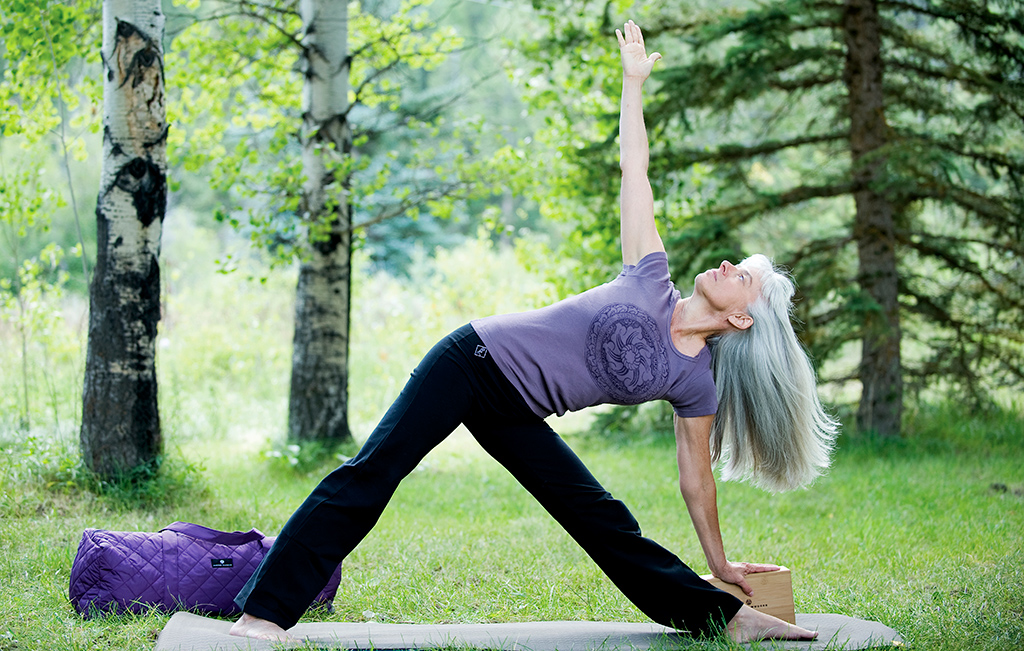
Trikonasana (Triangle Pose) is a pose that teaches us how to ground and expand simultaneously. In Trikonasana, we root deep into the earth and align ourselves to create a conduit for the energy of gravity.
Several years ago, Donna Farhi held a workshop here titled “Spinal Integration.” In the workshop she spoke about why standing poses are the “bread and butter” of B.K.S. Iyengar’s teaching and practice, especially in cases when the low back—where the kidneys reside—is compromised.
Here is what she said:
“You can work indirectly into the axial skeleton (the spine, skull and pelvis) through the appendicular skeleton (the limbs). The reason the standing postures are so powerful in this regard is that many of the poses keep the spine in a relatively neutral position. That is, the posture is not in and of itself demanding to the back. Yet in that neutral position one can move force from the ground through the legs into the spine, in the same way that water moves through a hose. When the impulse from the legs is transferred clearly into the pelvis and then into the spine, the impulse itself acts to open and clear the spine, in the same way that a high-pressure flow of water can clear a blockage in a hose.”
In my experience, Trikonasana is energizing precisely because a neutral spine, along with straight arms and legs, supports a continuous flow of energy throughout the body. Using your imagination, you may be able to visualize Trikonasana’s starfish-like shape: your head, tail, arms and legs radiating out from your center. When your limbs are in a position of continuity and your spine is neutral, the vital organs can rest easily inside your skeleton, allowing them to receive the energetic impulse from your legs.
How to Practice Trikonasana
- Begin by standing on a nonskid yoga mat with your legs one leg-length apart (three to four feet, depending on the length of your legs) and your feet parallel.
- Turn your right leg out 90 degrees so that the center of your thigh, knee and ankle are aligned with each other.
- Turn your left foot in (toward your right foot) about 30 degrees. This turn-in is necessary in order for the ankle, knee and thigh to align with each other.
- While grounding through your left foot, begin turning your left hip inward until you feel a connection between the left sit bone and left heel, and your left foot feels solidly grounded. Please note: This instruction is different from the way this pose is most often taught—to keep the hips aligned with each other on the horizontal plane. Over the years I found that keeping my hipbones aligned destabilized my sacroiliac joint, which led to sciatica and other painful problems. Letting the hip turn inward alleviates these issues, for me and for my students. In addition, in the traditional alignment, the back leg cannot ground as deeply as it can when my left hip turns inward. This places the skeleton in its most efficient position, allowing the muscles to relax along the bones.
- In one sweeping motion, lift your arms forward and up so that they extend out in front of you at shoulder level, and then open them out to the sides with your palms down.
- Ground your back leg as you extend your torso out over your right leg, tipping your pelvis to the right along with your spine.
- Place your hand on your right leg, a yoga block or the floor, depending on where you can reach and still maintain a neutral spine. Your chest, abdomen and face should face forward. This is essential to reaping the therapeutic benefits of a neutral spine that Donna explained.
- Take five to ten deep breaths, allowing your body to oscillate around the movement of your breath. You may turn your face to look up in your last couple breaths, but only if this doesn’t hurt your neck.
- To come out, ground your left foot and allow your torso to rise up to vertical. Turn your feet back to parallel and rest a few moments to feel what happened in the pose.
- Repeat on the other side.
Updated article from December 1, 2010
